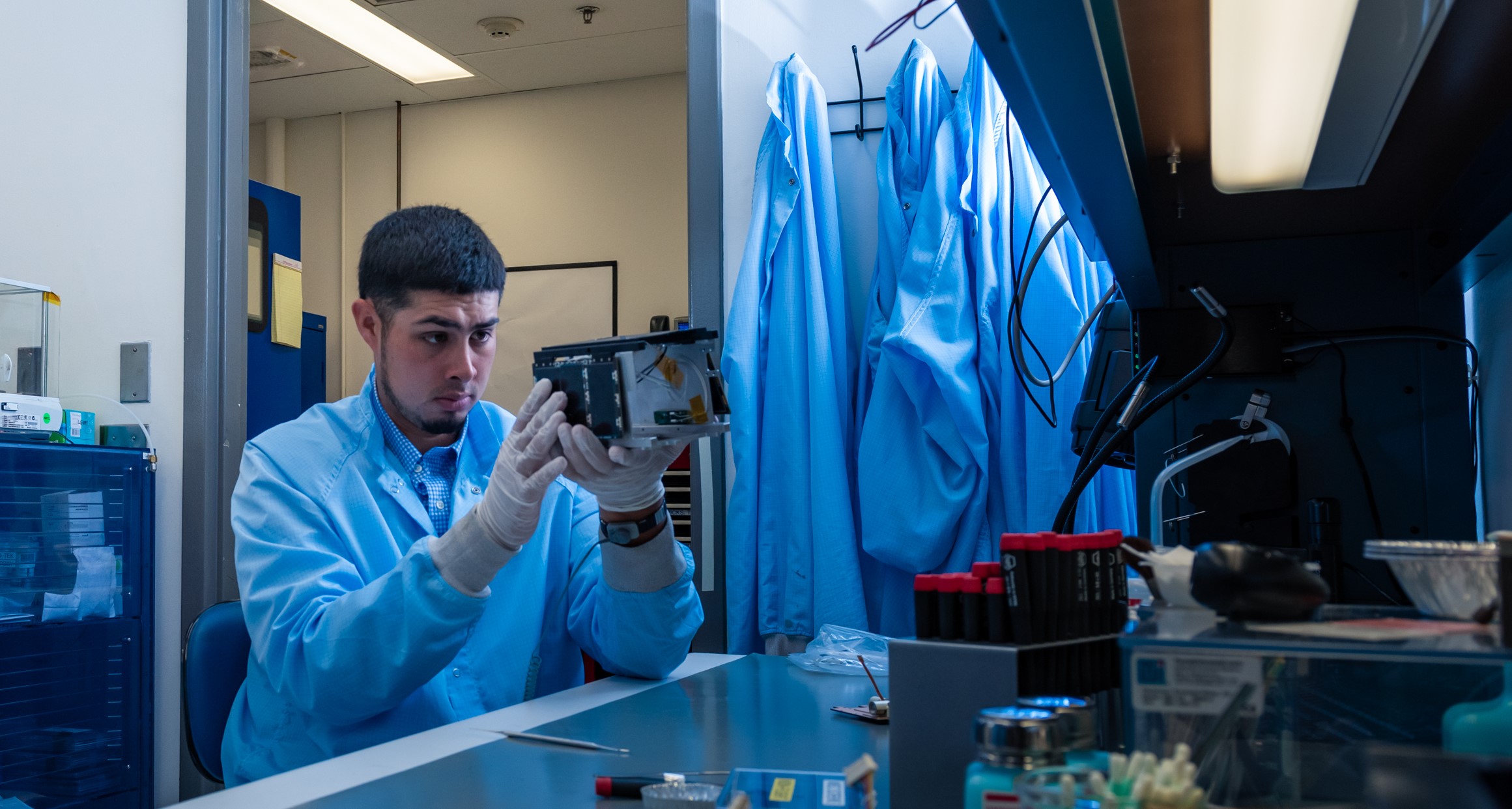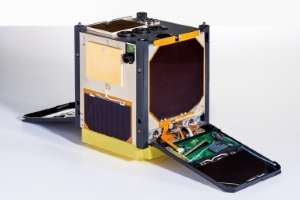The accelerating pace of space innovation in recent years has transformed what humans thought possible about reaching orbit, the moon and beyond. The proliferation of small satellites and their increasing popularity have been major catalysts for this revolution. Smallsats offer a number of significant advantages — including reducing costs exponentially while enabling enormous flexibility and experimentation for a broad spectrum of government and commercial space operators.
The Aerospace Corporation has been at the forefront of CubeSat technology and the miniaturization of satellites even before the CubeSat standard was established — flying the world's first containerized satellite 20 years ago. Through its AeroCube program, Aerospace continues to push the state of the art and build on its rich heritage as a leading pioneer in the CubeSat community.

Going Small in the ‘90s
Essentially all containerized satellites developed in the past decade conform to a CubeSat standard that was proposed in 1999, with the first actual CubeSat launching in 2003. However, Aerospace started flying containerized satellites even earlier, having established its smallsat program in the mid-1990s.

Though Aerospace’s earliest forays into space weren’t conventional CubeSats, they played a significant role in the development of the AeroCube program and growth of the CubeSat industry. In 2000, Aerospace flew the Orbiting Picosatellite Automated Launcher (OPAL) PicoSats, which were the world’s first containerized satellites. To deliver and deploy the OPAL PicoSats, the Aerospace team worked together with Stanford astronautics professor Bob Twiggs — who went on to be one of the co-developers of the CubeSat concept.
OPAL grew out of a combination of the Defense Advanced Research Projects Agency’s (DARPA) strong interest in microelectromechanical systems (MEMS) and Aerospace’s laboratories’ pursuit of producing ultra-miniaturized satellites that would be far less expensive to fly than the large satellites that were the norm at that time.
Although OPAL’s design meant it operated for only two weeks, the operation was successful and provided a proof-of-principle demonstration showing that it was possible to design, build, test, launch, deploy and get data from very small satellites.
Leading the CubeSat Revolution
When Aerospace started the development of PicoSats and AeroCubes, there were no commercial vendors for CubeSat-scale satellite subsystems or components. This gap prompted Aerospace to develop everything in-house. During this time, the corporation published papers on many of the components and subsystems developed or worked on, including miniature sun and Earth attitude sensors, miniature star trackers, characterization of MEMS gyroscopes, cold-gas and warm-gas propulsion systems, miniature reaction wheels, GPS-based orbit determination, optical communication transmitters, and characterization of production and experimental solar cells.

The earliest AeroCubes were focused on developing and demonstrating fundamental bus technologies needed to support future missions, such as power, communications, navigation, attitude control and propulsion. The core foundation of the AeroCube program was based on the PicoSat Solar Cell Testbed (PSSCT) that deployed from space shuttle Endeavour mission STS-126 in 2008. The follow-on PSSCT-2, which continued to mature the core spacecraft subsystems, deployed from STS-135, Atlantis in 2011.

AeroCube-4, which launched in 2012, established the state of the art for CubeSats by evolving from a technology demonstration platform to a fully functional mission-oriented spacecraft. Demonstrating the ability to track ground and space objects with the first 3-axis stabilized attitude-control system to fit in a one-unit CubeSat, AeroCube-4 went on to collect thousands of Earth images over an impressive seven-year mission life. The capabilities demonstrated by AeroCube-4 helped convince defense and NASA customers that CubeSats could execute real missions.
The advancements made up to this point enabled a low-cost, in-space testbed — a concept never before realized in this form. Even today, the CubeSat provides an effective testbed environment for miniaturized sensors and systems. This structure can test commercial parts and systems in an authentic environment while being an affordable option for space access via rideshare.
Unlocking New CubeSat Capabilities
As the AeroCube platform matured and Aerospace demonstrated precision pointing to under 1 degree, AeroCubes started taking on actual mission applications in the 2010s. For example, Aerospace was able to use CubeSats as optical tracking targets for space domain architecture demonstrations.
Besides being space-based optical tracking assets, AeroCube-4 and AeroCube-5 utilized multiple de-orbit enhancement devices after their primary missions were completed. The technologies employed helped find solutions to space traffic management issues.
The AeroCube-6 mission demonstrated the value of an affordable rapid space platform. In addition, AeroCube-6 was the first mission to show that variable atmospheric drag via orientation control could be used to manage relative orbit spacing.
AeroCube-7’s operations included high-speed optical data links, a technology that was later infused into various Aerospace-developed CubeSat demonstration missions and is currently used operationally to downlink gigabytes of payload image data. The AeroCube-7 laser transmitter design serves as a foundation utilized by multiple laser communication terminals under development throughout the small satellite industry.
In a series of missions, Aerospace has helped advance both visible and infrared imaging capabilities for the space enterprise. The CubeSat Multispectral Observing System (CUMULOS) payload, flown on the Integrated Solar Array & Reflectarray Antenna (ISARA) spacecraft, was an experiment in the performance of commercial, off-the-shelf (COTS) imaging systems in space. This technological design combined visible, short-wave infrared (SWIR) and long-wave infrared (LWIR) cameras into a single system.

Most recently, Aerospace’s CubeSat imaging experience was utilized for AeroCube-15 — a U.S. Space Force and Space and Missile Systems Center rapid reconstitution demonstration. The Aerospace Rogue Alpha/Beta spacecraft captured visible and SWIR imagery of weather phenomenology, such as Hurricane Sally, California wildfires, active volcanos and launch events. The imagery data obtained is being used to inform future experiments and support ground processing algorithm development.
Be sure to read Meet the AeroCube Fleet.
CubeSat Advancements on the Horizon
There has been an extended series of flights of eight spacecraft over the past five years as technology testbeds using the AeroCube platform. This testbed program provides an opportunity to invest in research and development of new space technologies, including materials, solar cells, radiation shielding, image sensors, advanced processors and thrusters, among others.
In many ways, the program also serves as an extension of the Aerospace laboratories into space in partnership with industry; the program reaches across Aerospace for ground testing and evaluation of new technologies, and then exercises these technologies in space. The ability to compare in-space and laboratory results provides a rapid and robust path to raising the technology readiness level (TRL) for technologies not previously considered for space applications. This type of affordable and rapid space flight testbed provides space readiness validation at the leading edge of the technology pipeline.
Aerospace also has a strong R&D solar cell technology-related program that has been able to leverage multiple AeroCube missions to provide timely data from experimental cells produced by domestic and international suppliers. These valuable performance measurements, which are conducted in space, have helped guide advancements in solar cell efficiencies over the past decade. Aerospace provides suppliers with on-orbit data and unique insights that would have been traditionally cost-prohibitive for them to obtain on their own. The AeroCube program provides the largest and most impactful on-orbit solar cell testbed capability in the world.

Recently, the AeroCube-10’s operations have indicated the further advancements that can be made. AeroCube-10 has an upgraded version of the propulsion system first included on AeroCube-7 and has been more successful in demonstrating proximity operations. In 2020, the two AeroCube-10 spacecraft approached each other while in orbit — within less than 25 meters — and obtained photos of the close encounter.
Innovating Outside the Box
Aerospace has a rich history of developing and flying CubeSat-scale spacecraft. Aerospace flew the world's first containerized spacecraft in 2000. We've delivered 39 spacecraft to date, with 20 still operational on orbit; Aerospace operates the world’s largest fleet of experimental CubeSats, a fleet that is exceeded in size only by the fleets of the commercial operators Planet and Spire.
The technologies developed for the AeroCube program, as well as the broader range of space technologies demonstrated by the AeroCube program, are having a significant effect on the space community. Techniques and technologies developed by Aerospace have been, and continue to be, adopted by others in the CubeSat community, even while we continue to push the envelope of what can be done with CubeSats.

Aerospace has a reputation for taking on the hard problems in space technology development, and our CubeSat program is able to push development of technologies that may not be of readily apparent value to industry. We took a leading role in showing the potential value of CubeSats in the space enterprise and continue to work to extend the boundaries of what can be done with kg-class spacecraft.
Be sure to read about our CubeSat milestones and what we're working on next.

